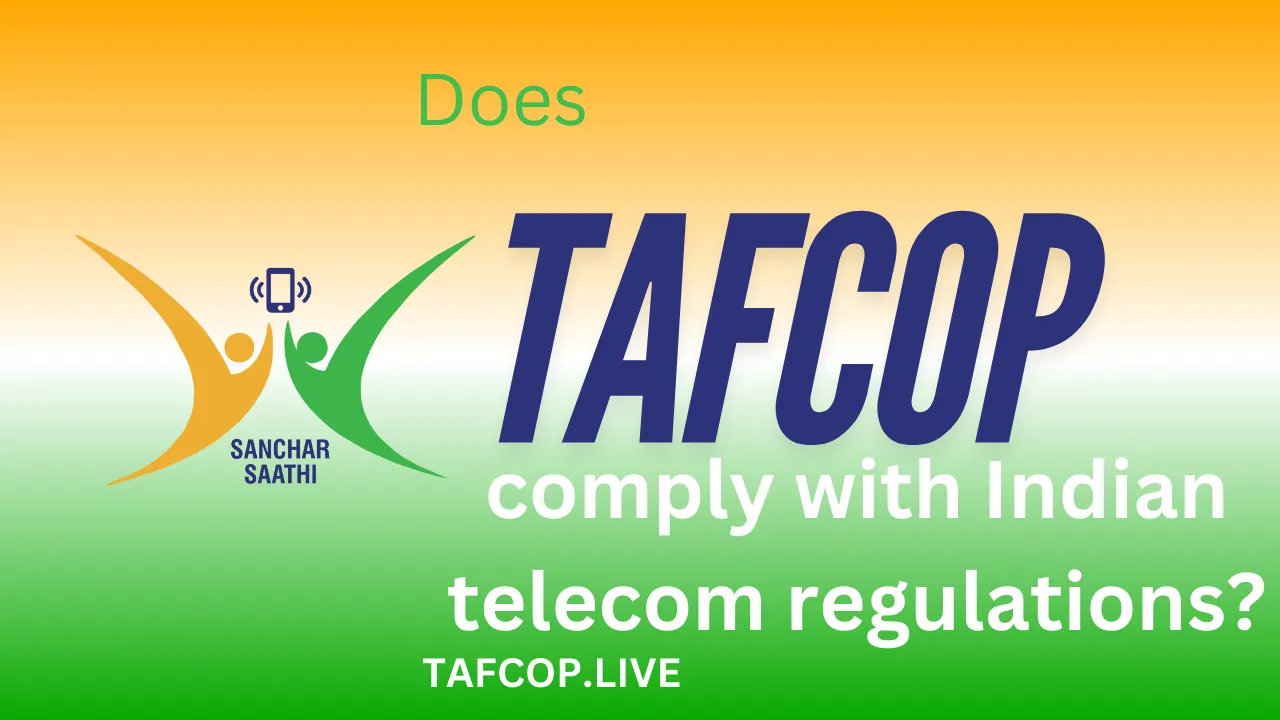When it comes to ensuring a fair and transparent telecom ecosystem in India, few initiatives have drawn as much attention as TAFCOP (Telecom Analytics for Fraud Management and Consumer Protection). It’s a name that’s rapidly gaining traction among telecom users who are eager to understand its implications. But does TAFCOP align with the robust framework of Indian telecom regulations? Let’s unpack this question.
Does TAFCOP comply with Indian telecom regulations?(Quick Answer)
Yes, TAFCOP complies with Indian telecom regulations. It functions under the directives of the Department of Telecommunications (DoT) and adheres to key mandates that ensure the protection of consumer rights, fraud prevention, and efficient telecom operations in India.
How does TAFCOP align with Indian telecom regulations?
India’s telecom regulations are designed to safeguard consumer interests, ensure fair practices, and prevent fraud. TAFCOP operates as a critical tool within this framework. Here’s how it aligns:
- Consumer Protection: The platform empowers users to check the number of mobile connections issued in their name, addressing a major concern of unauthorized usage.
- Fraud Detection: By identifying suspicious or fraudulent SIM card activations, TAFCOP adheres to the stringent Know Your Customer (KYC) guidelines mandated by the DoT.
- Regulatory Backing: TAFCOP’s foundation is rooted in the regulations outlined by the Indian Telegraph Act, 1885 and the Telecom Consumers Protection Regulations, 2012.
For instance, if a telecom subscriber finds more SIM cards registered in their name than they authorized, they can flag it through TAFCOP. This system helps telecom operators act promptly to deactivate unauthorized numbers, aligning with the regulation requiring accurate KYC compliance.
Why is TAFCOP important for telecom compliance in India?
Importance of TAFCOP in Compliance: TAFCOP serves as a bridge between regulatory compliance and consumer empowerment. The primary aim is to strengthen transparency and accountability in telecom operations.
Example of Use Case:
Consider this: Ravi, a resident of Chennai, discovers through TAFCOP that there are six mobile numbers registered under his name. He’s aware that he only authorized two. With a few clicks on TAFCOP’s portal, Ravi can flag the unauthorized numbers, triggering immediate action from his telecom service provider.
Such incidents underscore the platform’s significance in upholding the regulatory requirement of preventing identity misuse.
What are the core functions of TAFCOP?
TAFCOP performs several critical functions to ensure its compliance with Indian telecom regulations:
- Verification of Connections:
- Users can check all SIM cards registered under their name.
- Telecom operators can validate and rectify discrepancies in real-time.
- Fraud Prevention:
- By identifying unauthorized SIMs, it reduces the risk of fraudulent activities.
- Consumer Awareness:
- Through regular updates and alerts, TAFCOP educates users about their telecom rights and responsibilities.
Key Data:
| Core Function | Impact on Compliance |
|---|---|
| Verification of Connections | Promotes accurate KYC practices |
| Fraud Prevention | Mitigates risks of identity theft |
| Consumer Awareness | Enhances transparency and trust in telecom |
Does TAFCOP impact telecom operators’ responsibilities?
Yes, telecom operators have a heightened responsibility under TAFCOP’s framework. They must:
- Maintain precise records of consumer data.
- Respond promptly to TAFCOP-flagged complaints.
- Ensure compliance with KYC norms during the SIM activation process.
Quick Example: Imagine a telecom operator failing to deactivate a flagged unauthorized number within the stipulated time. Such negligence could attract regulatory penalties, emphasizing the need for strict adherence.
What challenges does TAFCOP address in the Indian telecom sector?
The Indian telecom landscape is vast, with millions of connections being activated every day. This growth brings challenges such as:
- Identity Theft: Unauthorized SIM issuance leads to misuse of consumer identities.
- Fraudulent Activities: Fake SIM activations can facilitate scams, threatening national security.
- Consumer Unawareness: Many users are unaware of how many connections are linked to their ID.
TAFCOP’s Role: By offering a centralized platform for connection verification, TAFCOP tackles these issues head-on. It encourages informed decision-making and reduces the scope of fraud.
Are there any limitations to TAFCOP?
While TAFCOP is a revolutionary step, it’s not without limitations:
- Awareness Gap: Not all users are aware of TAFCOP’s existence or its functions.
- Internet Dependence: The platform requires online access, which may be a hurdle in rural areas.
- Operator Response Time: Despite TAFCOP’s efficiency, delays from telecom operators can hamper swift resolution.
How to Overcome These Challenges:
Increasing public awareness through campaigns and improving rural internet infrastructure can amplify TAFCOP’s impact.
How can Indian consumers use TAFCOP effectively?
Using TAFCOP is straightforward and highly beneficial. Here’s a step-by-step guide:
- Visit the TAFCOP Portal: Log on to the official website (https://tafcop.dgtelecom.gov.in).
- Enter Mobile Number: Provide your registered mobile number to receive an OTP.
- Review Registered Connections: Check all SIMs linked to your name.
- Flag Unauthorized Numbers: Report any discrepancies for prompt action.
“With TAFCOP, Indian telecom users finally have a voice to challenge unauthorized SIM misuse—a critical step toward a transparent digital ecosystem.”
Conclusion
TAFCOP undeniably complies with Indian telecom regulations, acting as a cornerstone for consumer protection and fraud prevention. By leveraging the platform, India’s telecom users can safeguard their identities, while operators ensure adherence to regulatory mandates. Although challenges exist, the initiative’s potential to foster trust and transparency in the telecom sector is unparalleled.
In essence, TAFCOP represents the evolution of consumer-centric governance in India’s telecom landscape—a necessary stride toward accountability and efficiency. So, if you haven’t explored TAFCOP yet, now’s the time to take charge of your telecom identity. Remember, knowledge is power, and TAFCOP puts that power in your hands.

